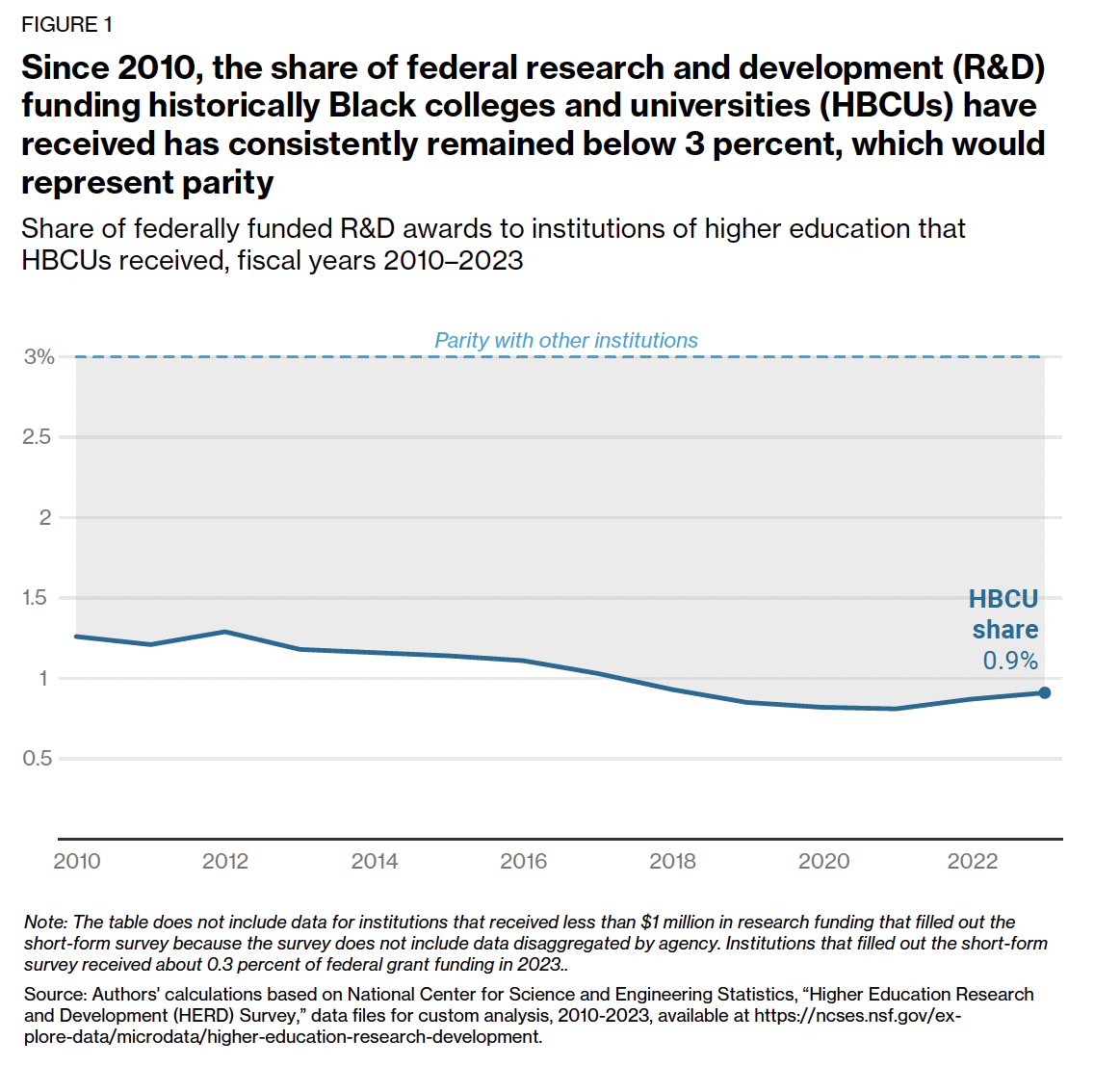HBCU Research Funding: Improving R&D Allocation to Historically Black Colleges and Universities
October 15, 2025
Despite driving STEM achievement and economic mobility, Historically Black Colleges and Universities (HBCUs) continue to receive less than one percent of federal research and development funding. Addressing this imbalance is key to strengthening innovation and state economies.
Authors: Zachary Tucker, Higher Education Impact Fellow, The Hunt Institute | Javaid Siddiqi, Ph.D., President and CEO, The Hunt Institute
Historically Black Colleges and Universities (HBCUs) are among the nation’s most effective pathways for educational attainment and upward mobility—particularly in science, technology, engineering, and mathematics (STEM). Yet despite their proven impact, they remain vastly underfunded in federal research and development (R&D) allocations.
A recent report from the Center for American Progress (CAP) and the Thurgood Marshall College Fund (TMCF) notes that HBCUs received less than one percent of the approximately $60 billion in federal R&D expenditures at colleges and universities in 2023.
To provide context, the report calculates that all HBCUs that received federal R&D funding, when combined, amounted to about 16 percent of the funding awarded to Johns Hopkins University, the top-funded institution that year.

Federal research funding is highly competitive, with awards typically based on a proposal’s perceived scientific merit and potential impact. From this viewpoint, the primary goal is to fund the most promising research, regardless of the institution.
Some observers point to the existing research capacity at well-funded universities as a natural outcome of this competitive research.
The CAP/TMCF report, however, identifies systematic factors that can affect this competition, including the challenges that under-resourced institutions face in building the infrastructure and track record needed to compete for grants, as well as documented biases in the review process itself.
Why it Matters for States
Federal R&D investments are a recognized driver of economic and scientific innovation. These funds help build labs, recruit top talent, and provide students with hands-on research experience. When certain institutions face persistent barriers to accessing these resources, the effects extend beyond their campuses.
When HBCUs are excluded from these resources, the effects ripple outward. Students miss out on hands-on research opportunities, institutions struggle to attract and retain faculty, and communities may miss out on associated economic benefits.
The report highlights that approximately 85% of HBCUs are located in economically underdeveloped “HUBZones,” suggesting that strengthening these institutions could also spur local job creation and economic development.
For state policymakers, this connects directly to workforce development and economic competitiveness. A diverse, skilled STEM workforce is widely seen as essential for state and national economic growth.
Data from the National Science Foundation show that all HBCUs combined receive less federal funding support than a single well-funded predominantly white institution. That imbalance weakens regional economies, particularly in places where HBCUs serve as anchor institutions and major employers.

Policy Considerations
There is no single fix, but policymakers looking to improve funding for their local HBCUs can:
- Strengthen research capacity at HBCUs through matching grants, infrastructure funding, and targeted R&D investments.
- Expand access to federal funding pipelines by reducing administrative barriers and increasing technical support for grant applications.
- Create equitable funding formulas that ensure state research investments flow proportionately to HBCUs.
- Encourage public-private partnerships that leverage corporate R&D priorities with the unique strengths of HBCUs.
Some states are already moving in this direction. For instance, legislatures in Tennessee and Maryland have implemented historic settlements and funding boosts to address decades of underfunding for HBCUs. These examples provide models for other states to consider as they seek to strengthen higher education ecosystems.
The Future of HBCU Research Funding
Fostering a robust and inclusive national research ecosystem is a complex challenge with significant implications for innovation and economic mobility. HBCUs have a proven track record of educating a diverse STEM workforce. Ensuring that a wide range of institutions have the capacity to participate fully in federally funded research is a consideration for policymakers focused on long-term economic competitiveness.
Considerations for Policymakers
- Examine your state’s R&D allocations to understand how HBCUs are being funded.
- Consider legislative options to support research infrastructure and grant-writing assistance at under-resourced institutions.
- Engage directly with HBCU leaders to understand barriers to accessing federal funding and identify opportunities for state partnership.
As states work to build a strong talent pipeline and competitive economy, examining the role of all postsecondary institutions in the research landscape is a key step.
To explore TMCF’s research in greater detail and access the full report, click here.


